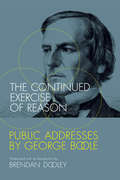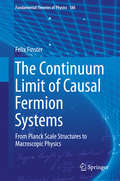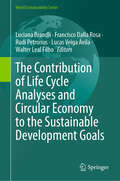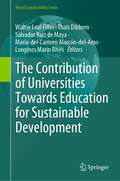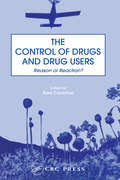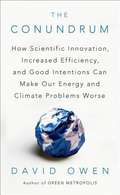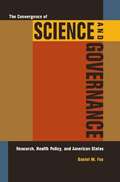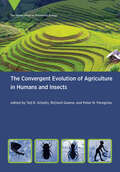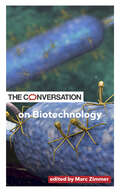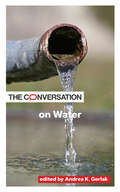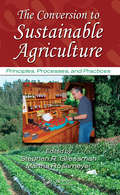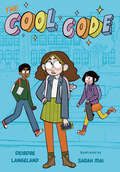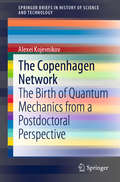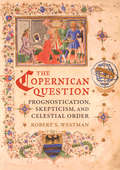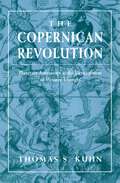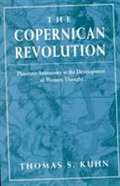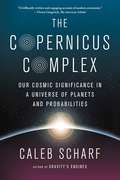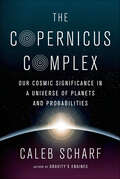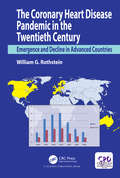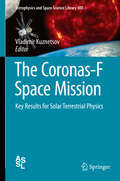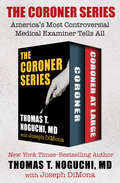- Table View
- List View
The Continued Exercise of Reason: Public Addresses by George Boole (The\mit Press Ser.)
by Brendan DooleyLectures, many never before published, that offer insights into the early thinking of the mathematician and polymath George Boole.George Boole (1815–1864), remembered by history as the developer of an eponymous form of algebraic logic, can be considered a pioneer of the information age not only because of the application of Boolean logic to the design of switching circuits but also because of his contributions to the mass distribution of knowledge. In the classroom and the lecture hall, Boole interpreted recent discoveries and debates in a wide range of fields for a general audience. This collection of lectures, many never before published, offers insights into the early thinking of an innovative mathematician and intellectual polymath.Bertrand Russell claimed that “pure mathematics was discovered by Boole,” but before Boole joined a university faculty as professor of mathematics in 1849, advocacy for science and education occupied much of his time. He was deeply committed to the Victorian ideals of social improvement and cooperation, arguing that “the continued exercise of reason” joined all disciplines in a common endeavor. In these talks, Boole discusses the genius of Isaac Newton; ancient mythologies and forms of worship; the possibility of other inhabited planets in the universe; the virtues of free and open access to knowledge; the benefits of leisure; the quality of education; the origin of scientific knowledge; and the fellowship of intellectual culture. The lectures are accompanied by a substantive introduction by Brendan Dooley, the editor of the volume, that supplies biographical and historical context.
The Continuum Limit of Causal Fermion Systems
by Felix FinsterThis monograph introduces the basic concepts of the theory of causal fermion systems, a recent approach to the description of fundamental physics. The theory yields quantum mechanics, general relativity and quantum field theory as limiting cases and is therefore a candidate for a unified physical theory. From the mathematical perspective, causal fermion systems provide a general framework for describing and analyzing non-smooth geometries and "quantum geometries. " The dynamics is described by a novel variational principle, called the causal action principle. In addition to the basics, the book provides all the necessary mathematical background and explains how the causal action principle gives rise to the interactions of the standard model plus gravity on the level of second-quantized fermionic fields coupled to classical bosonic fields. The focus is on getting a mathematically sound connection between causal fermion systems and physical systems in Minkowski space. The book is intended for graduate students entering the field, and is furthermore a valuable reference work for researchers in quantum field theory and quantum gravity.
The Contrarian: Peter Thiel and Silicon Valley's Pursuit of Power
by Max ChafkinA biography of venture capitalist and entrepreneur Peter Thiel, the enigmatic, controversial, and hugely influential power broker who sits at the dynamic intersection of tech, business, and politics &“Max Chafkin&’s The Contrarian is much more than a consistently shocking biography of Peter Thiel, the most important investor in tech and a key supporter of the Donald Trump presidency. It&’s also a disturbing history of Silicon Valley that will make you reconsider the ideological foundations of America&’s relentless engine of creative destruction.&”—Brad Stone, author of The Everything Store and Amazon UnboundSince the days of the dot-com bubble in the late 1990s, no industry has made a greater impact on the world than Silicon Valley. And few individuals have done more to shape Silicon Valley than Peter Thiel. The billionaire venture capitalist and entrepreneur has been a behind-the-scenes operator influencing countless aspects of our contemporary way of life, from the technologies we use every day to the delicate power balance between Silicon Valley, Wall Street, and Washington. But despite his power and the ubiquity of his projects, no public figure is quite so mysterious.In the first major biography of Thiel, Max Chafkin traces the trajectory of the innovator's singular life and worldview, from his upbringing as the child of immigrant parents and years at Stanford as a burgeoning conservative thought leader to his founding of PayPal and Palantir, early investment in Facebook and SpaceX, and relationships with fellow tech titans Mark Zuckerberg, Elon Musk, and Eric Schmidt. The Contrarian illuminates the extent to which Thiel has sought to export his values to the corridors of power beyond Silicon Valley, including funding the lawsuit that destroyed the blog Gawker and strenuously backing far-right political candidates, notably Donald Trump for president in 2016. Eye-opening and deeply reported, The Contrarian is a revelatory biography of a one-of-a-kind leader and an incisive portrait of a tech industry whose explosive growth and power is both thrilling and fraught with controversy.
The Contribution of Life Cycle Analyses and Circular Economy to the Sustainable Development Goals (World Sustainability Series)
by Walter Leal Filho Luciana Brandli Francisco Dalla Rosa Rudi Petrorius Lucas Veiga AvilaThis book offers a comprehensive review of life cycle assessment (LCA), circular economy (CE), and sustainable development, exploring their achievements and progress across the world. The book also emphasizes the significant contribution of LCA and CE to achieving the Sustainable Development Goals (SDGs), demonstrating how these frameworks can drive progress toward global sustainability targets. The main topics covered include the environmental and economic assessment of building materials, the life cycle of agricultural and bio-based products, the role of venture businesses in promoting CE, and the impact of CE on sustainable development. Additionally, the book discusses energy optimization in supply chains, the nexus between comparative advantage and the bio-based economy, and the use of CE frameworks in energy management for educational institutions. Key chapters highlight the valorization of waste materials for bioethanol production, the evolution of LCA studies on electric vehicle batteries, and the implementation of EDGE certification in Brazilian public schools. The book also explores the integration of LCA and CE in architectural education, the challenges and barriers to CE adoption in Nigeria, and the role of public policy in advancing CE in Brazil. These topics are critically important as they address the pressing need for sustainable practices in various industries. The integration of LCA and CE principles is crucial for minimizing environmental impacts, optimizing resource use, and fostering innovation in sustainable development. The book aims to solve the problem of how to effectively incorporate these principles into practice, providing methodological approaches, case studies, and policy perspectives that illustrate successful implementations and identify areas for improvement. The target audience for this book includes researchers, policymakers, industry professionals, and students interested in sustainability, environmental science, and circular economy practices. By offering in-depth analysis and practical insights, this book serves as a valuable resource for anyone seeking to understand and apply LCA and CE principles to achieve sustainable development goals.
The Contribution of Mathematics to School STEM Education: Current Understandings
by Katie Makar Judy AndersonThis book presents contemporary STEM education research conducted by mathematics education researchers and their collaborators which highlights the important and pivotal role of mathematics in school STEM education. It showcases evidence of the types of integrated curriculum approaches to STEM education which highlight mathematics as a key component and where mathematical concepts can be learnt through integrated tasks. These examples challenge the idea that mathematics is just an application or ‘servant’ to the other STEM subjects and highlight the contribution that mathematics can make to the understanding and practices of the other STEM subjects. This book fills a void in the current research literature on the role of mathematics in STEM education, provides evidence of the possibilities for designing integrated STEM curriculum and highlights current understandings of the role of mathematics in school STEM education. For researchers, it identifies and elaborates gaps to encourage further exploration in this field.
The Contribution of Universities Towards Education for Sustainable Development (World Sustainability Series)
by Walter Leal Filho Thais Dibbern Salvador Ruiz de Maya María-del-Carmen Alarcón-del-Amo Longinos Marin RivesThe book gathers inputs from universities and research organizations working on matters related to sustainable development in a variety of contexts. It also provides a platform for the dissemination of information on the latest initiatives, paving the way for technology transfer and networking. Furthermore, the book intends to provide a fertile basis upon which universities may cooperate more closely in this key area. Universities, as centers of education, research, and innovation, have a unique position and responsibility in promoting sustainability. They can offer degree programs, courses, and workshops focused on sustainability, environmental studies, and related fields, educating students and the wider community about the principles and challenges of sustainability. Also, universities can conduct cutting-edge research to address sustainability challenges, such as climate change, resource depletion, and biodiversity loss. They can develop innovative technologies and solutions that promote sustainable practices in various sectors, including energy, agriculture, transportation, and urban planning. There is a perceived need to better understand and engage universities further on sustainability initiatives. Against this backdrop and in order to facilitate a broad discussion on the contribution of universities toward sustainability, this book is being produced.Last but not least, a further aim of the book is to present methodological approaches and experiences deriving from case studies and projects, which aim to show how sustainability may be incorporated as part of university programs.
The Control Of Nature
by John McpheeThese three essays center around man's influence on nature and how it (nature) fights back. The First essay centers on New Orleans and how man's influence has contributed to it's now demise. Though written in 1989, Mcphee's research pretty much describes how Katrina, or in the case of the book, a theoretical storm, could have been made much less destructive had development been much less. The second article discusses efforts in Iceland to cool lava with saltwater and stop the destruction of a town. The third describes Los Angeles's expansion and possible demise due to run off and mud slides from the San Gabriel mountains. His premise in all three articles basically is, nature will ultimately have the last word in it's ultimate design.
The Control of Drugs and Drug Users: Reason or Reaction?
by Ross CoomberInformed debate on how, why, or even if, drugs and those that use them should be controlled needs an insight into the background of such controls, how effective they have been and what reasonable alternatives there may be. This book seeks to provide such an insight. Reviewing important aspects of past and current drug control policies in Britain and America, the international compliment of expert contributors seek to explore the rationality of the reasoning which produced the initial controls, the continuing relevance of those currently employed, and provide alternative scenarios for future policy.
The Conundrum: How Scientific Innovation, Increased Efficiency, and Good Intentions Can Make Our Energy and Climate Problems Worse
by David OwenThe Conundrum is a mind-changing manifesto about the environment, efficiency, and the real path to sustainability.
The Convergence of Science and Governance: Research, Health Policy, and American States
by Daniel M. FoxThis book tells related stories about health politics and policy in the U.S.during the past century--the recent convergence of science and governance in policy for covering pharmaceutical drugs in public programs in most American states and explain why and how this convergence occurred.
The Convergent Evolution of Agriculture in Humans and Insects (Vienna Series in Theoretical Biology)
by Ted R. Schultz, Richard Gawne, and Peter N. PeregrineContributors explore common elements in the evolutionary histories of both human and insect agriculture resulting from convergent evolution.During the past 12,000 years, agriculture originated in humans as many as twenty-three times, and during the past 65 million years, agriculture also originated in nonhuman animals at least twenty times and in insects at least fifteen times. It is much more likely that these independent origins represent similar solutions to the challenge of growing food than that they are due purely to chance. This volume seeks to identify common elements in the evolutionary histories of both human and insect agriculture that are the results of convergent evolution. The goal is to create a new, synthetic field that characterizes, quantifies, and empirically documents the evolutionary and ecological mechanisms that drive both human and nonhuman agriculture. The contributors report on the results of quantitative analyses comparing human and nonhuman agriculture; discuss evolutionary conflicts of interest between and among farmers and cultivars and how they interfere with efficiencies of agricultural symbiosis; describe in detail agriculture in termites, ambrosia beetles, and ants; and consider patterns of evolutionary convergence in different aspects of agriculture, comparing fungal parasites of ant agriculture with fungal parasites of human agriculture, analyzing the effects of agriculture on human anatomy, and tracing the similarities and differences between the evolution of agriculture in humans and in a single, relatively well-studied insect group, fungus-farming ants.
The Conversation on Biotechnology (Critical Conversations)
by Marc ZimmerFrom the contributors to The Conversation, this collection of essays by leading experts in biotechnology provides foundational knowledge on a range of topics, from CRISPR gene sequencing to the ethics of GMOs and "designer babies."In The Conversation on Biotechnology, editor Marc Zimmer collects essays from The Conversation U.S. by top scholars and experts in the field, who present a primer on the latest biotechnology research, the overwhelming possibilities it offers, and the risks of its abuse. From an overview of CRISPR technology and gene editing in GMOs to the ethical questions surrounding "designer babies" and other applications of biotechnology in humans, it highlights the major implications biotechnology will bring for health and society. Topics range from the spectacular use of light to fire individual neurons in the brain to making plant-based meats; from curbing diseases with genetically modified mosquitoes to looking back on 40 years of opinions on IVF babies.The Critical Conversations series collects essays from top scholars on timely topics, including water, biotechnology, gender diversity, gun culture, and more, originally published on the independent news site The Conversation U.S.Contributors: Nathan Ahlgren, Ivan Anishchenko, Trine Antonsen, Jennifer Barfield, Pedro Belda-Ferre, Ari Berkowitz, Adeline Boettcher, Jason Delbourne, Kevin Doxzen, Mo Ebrahimkhani, Eleanor Feingold, J. Benjamin Hurlbut, Cecile Janssens, Samira Kiani, Amanda Kowalczyk, Mariana Lamas, Andrew Lapworth, Rebecca Mackelprang, Kathleen Merrigan, Saman Naghieh, Sean Nee, Dimitri Perrin, Christopher Preston, Jason Rasgon, Penny Riggs, Jason Robert, Oliver Rogoyski, Gary Samore, Sahotra Sarkar, George E. Seidel, Patricia A. Stapleton, Craig W. Stevens, Paul B. Thompson, Christopher Tuggle, Vikramaditya G. Yadav, Marc Zimmer
The Conversation on Water (Critical Conversations)
by Andrea K. GerlakFrom the contributors to The Conversation, a compelling essay collection on the world's water crises and the necessary steps to build a more sustainable and equitable water future for all.Water-related crises are affecting more and more communities, both in the United States and internationally. If we continue to delay upgrading our infrastructure and addressing rising environmental concerns, we risk further destabilizing already strained systems—or, worse, causing a catastrophic collapse. In The Conversation on Water, water scholar and professor Andrea K. Gerlak collects essays from The Conversation U.S. on critical issues related to water from leading experts in everything from public policy to environmental engineering.Gerlak pays special attention to the threats facing our water systems today—covering insufficient infrastructure, climate change, and pollution—and integrates them with essays on technologies for harvesting water and Indigenous knowledge in governing the oceans. She then proposes solutions that present opportunities for hope and reform. From new partnerships and collaborative efforts to alternative governance practices and new scientific tools and community approaches, readers will learn about viable pathways forward and will understand the deep social and political dimensions of water governance. Understanding these challenges is the first step toward building a more sustainable and equitable water future for all. The Critical Conversations series collects essays from top scholars on timely topics, including water, biotechnology, gender diversity, gun culture, and more, originally published on the independent news site The Conversation U.S. Contributors: Roger Bales, Kevin Befus, Robert Blasiak, Ellen Bruno, Bethany Caruso, Sebastien Chastin, Craig E. Colten, Joseph Cook, Michelle DiBenedetto, Farshid Felfelani, Gabriel Filippelli, Michail Georgiou, Burke Griggs, Gary Griggs, Drew Gronewold, Marissa Grunes, Danielle Hare, Brian Haus, Dan Johnson, Carol Kwiatkowski, Rosalyn R. LaPier, Katharine Mach, Amahia Mallea, Daniel McCool, Jacob Miller-Klugesherz, Nobuhito Mori, Thomas Mortlock, Suzanne O'Connell, Itxaso Odériz, Joseph D. Ortiz, Meg Parsons, Raquel Partelli-Feltrin, Yadu Pokhrel, Manzoor Qadir, Julie Reimer, Landolf Rhode-Barbarigos, Richard Rood, Asher Rosinger, Matthew R. Sanderson, Heidi Schweizer, Alan Seltzer, A. R. Siders, Rodolfo Silva-Casarín, Vladimir Smakhtin, Bruce Sutherland, Lara Taylor, Emily Ury, Ton Van den Bremer, Andrew J. Whelton
The Conversion to Sustainable Agriculture: Principles, Processes, and Practices (Advances in Agroecology)
by Stephen R. Gliessman Martha RosemeyerWith all of the environmental and social problems confronting our food systems today, it is apparent that none of the strategies we have relied on in the pasthigher-yielding varieties, increased irrigation, inorganic fertilizers, pest damage reductioncan be counted on to come to the rescue. In fact, these solutions are now part of the problem. It i
The Cool Code (The Cool Code #1)
by Deirdre LangelandIn this funny and heartfelt slice-of-life graphic novel for fans of Raina Telgemeier and Kayla Miller, when coding whiz Zoey goes from homeschooled to new school, she develops an app to help her make friends. Will the Cool Code help Zoey fit in? Or will it completely crash her social life?In an attempt to fit in, Zoey develops an app called the Cool Code with a cute llama avatar that will tell her everything from what to say to what to wear based on pop culture algorithms she’s uploaded.But when the app gives her ridiculous advice, awkwardness and hilarity ensues. With a few upgrades and a bit of debugging from the coding club, the app actually works—Zoey gets really popular . . . and gets her pulled in all kinds of directions, including away from her real friends.Life’s most complicated choices. . . is there a code for that?
The Cooling
by Lowell PonteAre we entering a new ice age? Many scientists think so. Many others say that the climate is becoming unstable, and that this instability is a critical threat to world food production. Earth's climate has been cooling rapidly for the past three decades, and this has already caused drought and famine in major areas of the world. In the time it takes you to read this book, at least a thousand people will have starved to death because of the impact climatic instability already has had on food production. And The Cooling has barely begun. Few questions are as urgent today as those concerning climate change and what may be done about it. Dr. Cesare Emiliani, a "paleoclimatologist" at the University of Miami, says: "Is Earth's climate changing? Should governments try to modify climate? In dealing with these controversial issues, Lowell Ponte has written a remarkably thorough, far-ranging, balanced, and scientifically accurate book-the best popular book I have read on both these questions. I recommend THE COOLING to anyone who likes to think, and who cares about the planet we share."
The Copenhagen Network: The Birth of Quantum Mechanics from a Postdoctoral Perspective (SpringerBriefs in History of Science and Technology)
by Alexei KojevnikovThis book is a historical analysis of the quantum mechanical revolution and the emergence of a new discipline from the perspective, not of a professor, but of a recent or actual Ph.D. student just embarking on an uncertain academic career in economically hard times. Quantum mechanics exploded on to the intellectual scene between 1925 and 1927, with more than 200 publications across the world, the majority of them authored by young scientists under the age of 30, graduate students or postdoctoral fellows. The resulting theory was a collective product that no single authority could claim, but it had a major geographical nod – the Copenhagen Institute of Theoretical Physics – where most of the informal, pre-published exchange of ideas occurred and where every participant of the new community aspired to visit. A rare combination of circumstances and resources – political, diplomatic, financial, and intellectual – allowed Niels Bohr to establish this “Mecca” of quantum theory outside of traditional and more powerful centres of science. Transitory international postdoctoral fellows, rather than established professors, developed a culture of research that became the source of major innovations in the field. Temporary assistantships, postdoctoral positions, and their equivalents were the chief mode of existence for young academics during the period of economic crisis and post-WWI international tensions. Insecure career trajectories and unpredictable moves through non-stable temporary positions contributed to their general outlook and interpretations of the emerging theory of quantum mechanics. This book is part of a four-volume collection addressing the beginnings of quantum physics research at the major European centres of Göttingen, Copenhagen, Berlin, and Munich; these works emerged from an expansive study on the quantum revolution as a major transformation of physical knowledge undertaken by the Max Planck Institute for the History of Science and the Fritz Haber Institute (2006–2012).
The Copernican Question: Prognostication, Skepticism, and Celestial Order
by Robert S. WestmanIn 1543, Nicolaus Copernicus publicly defended his hypothesis that the earth is a planet and the sun a body resting near the center of a finite universe. But why did Copernicus make this bold proposal? And why did it matter? The Copernican Question reframes this pivotal moment in the history of science, centering the story on a conflict over the credibility of astrology that erupted in Italy just as Copernicus arrived in 1496. Copernicus engendered enormous resistance when he sought to protect astrology by reconstituting its astronomical foundations. Robert S. Westman shows that efforts to answer the astrological skeptics became a crucial unifying theme of the early modern scientific movement. His interpretation of this "long sixteenth century," from the 1490s to the 1610s, offers a new framework for understanding the great transformations in natural philosophy in the century that followed.
The Copernican Revolution: Planetary Astronomy In The Development Of Western Thought
by Thomas KuhnThe Copernican Revolution: Planetary Astronomy In The Development Of Western Thought
The Copernican Revolution: Planetary Astronomy in the Development of Western Thought
by Thomas S. KuhnFor scientist and layman alike this book provides vivid evidence that the Copernican Revolution has by no means lost its significance today. Few episodes in the development of scientific theory show so clearly how the solution to a highly technical problem can alter our basic thought processes and attitudes. Understanding the processes which underlay the Revolution gives us a perspective, in this scientific age, from which to evaluate our own beliefs more intelligently. With a constant keen awareness of the inseparable mixture of its technical, philosophical, and humanistic elements, Thomas S. Kuhn displays the full scope of the Copernican Revolution as simultaneously an episode in the internal development of astronomy, a critical turning point in the evolution of scientific thought, and a crisis in Western man s concept of his relation to the universe and to God. The book begins with a description of the first scientific cosmology developed by the Greeks. Mr. Kuhn thus prepares the way for a continuing analysis of the relation between theory and observation and belief. He describes the many functions astronomical, scientific, and nonscientific of the Greek concept of the universe, concentrating especially on the religious implications. He then treats the intellectual, social, and economic developments which nurtured Copernicus break with traditional astronomy. Although many of these developments, including scholastic criticism of Aristotle s theory of motion and the Renaissance revival of Neoplatonism, lie entirely outside of astronomy, they increased the flexibility of the astronomer s imagination. That new flexibility is apparent in the work of Copernicus, whose De Revolutionibus Orbium Coelestium (On the Revolutions of the Heavenly Spheres) is discussed in detail both for its own significance and as a representative scientific innovation. With a final analysis of Copernicus life work its reception and its contribution to a new scientific concept of the universe Mr. Kuhn illuminates both the researches that finally made the heliocentric arrangement work, and the achievements in physics and metaphysics that made the planetary earth an integral part of Newtonian science. These are the developments that once again provided man with a coherent and self-consistent conception of the universe and of his own place in it. This is a book for any reader interested in the evolution of ideas and, in particular, in the curious interplay of hypothesis and experiment which is the essence of modern science. Says James Bryant Conant in his Foreword: Professor Kuhn s handling of the subject merits attention, for he points the way to the road which must be followed if science is to be assimilated into the culture of our times.
The Copernicus Complex: Our Cosmic Significance in a Universe of Planets and Probabilities
by Caleb ScharfNicolaus Copernicus dared to go against the establishment by proposing that Earth rotates around the Sun. Having demoted Earth from its unique position in the cosmos to one of mediocrity, Copernicus set in motion a revolution in scientific thought. <P><P>This perspective has influenced our thinking for centuries. However, recent evidence challenges the Copernican Principle, hinting that we do in fact live in a special place, at a special time, as the product of a chain of unlikely events. But can we be significant if the Sun is still just one of a billion trillion stars in the observable universe? <P><P>And what if our universe is just one of a multitude of others-a single slice of an infinity of parallel realities? In The Copernicus Complex, the renowned astrophysicist Caleb Scharf takes us on a scientific adventure, from tiny microbes within the Earth to distant exoplanets, probability theory, and beyond, arguing that there is a solution to this contradiction, a third way of viewing our place in the cosmos, if we weigh the evidence properly. <P><P>As Scharf explains, we do occupy an unusual time in a 14-billion-year-old universe, in a somewhat unusual type of solar system surrounded by an ocean of unimaginable planetary diversity: hot Jupiters with orbits of less than a day, planet-size rocks spinning around dead stars, and a wealth of alien super-Earths. Yet life here is built from the most common chemistry in the universe, and we are a snapshot taken from billions of years of biological evolution. <P><P>Bringing us to the cutting edge of scientific discovery, Scharf shows how the answers to fundamental questions of existence will come from embracing the peculiarity of our circumstance without denying the Copernican vision. <P><P> With characteristic verve, Scharf uses the latest scientific findings to reconsider where we stand in the balance between cosmic significance and mediocrity, order and chaos. <P><P> Presenting a compelling and bold view of our true status,The Copernicus Complex proposes a way forward in the ultimate quest: determining life's abundance, not just across this universe but across all realities.
The Copernicus Complex: Our Cosmic Significance in a Universe of Planets and Probabilities
by Caleb ScharfLonglisted for the 2015 PEN/E.O. Wilson Literary Science Writing AwardShort-listed for Physics World's Book of the YearThe Sunday Times (UK) Best Science Book of 2014A Publishers Weekly Top 10 Science Book of Fall 2014An NBC News Top Science and Tech Book of 2014A Politics & Prose 2014 Staff PickIn the sixteenth century, Nicolaus Copernicus dared to go against the establishment by proposing that Earth rotates around the Sun. Having demoted Earth from its unique position in the cosmos to one of mediocrity, Copernicus set in motion a revolution in scientific thought. This perspective has influenced our thinking for centuries. However, recent evidence challenges the Copernican Principle, hinting that we do in fact live in a special place, at a special time, as the product of a chain of unlikely events. But can we be significant if the Sun is still just one of a billion trillion stars in the observable universe? And what if our universe is just one of a multitude of others-a single slice of an infinity of parallel realities?In The Copernicus Complex, the renowned astrophysicist Caleb Scharf takes us on a scientific adventure, from tiny microbes within the Earth to distant exoplanets, probability theory, and beyond, arguing that there is a solution to this contradiction, a third way of viewing our place in the cosmos, if we weigh the evidence properly. As Scharf explains, we do occupy an unusual time in a 14-billion-year-old universe, in a somewhat unusual type of solar system surrounded by an ocean of unimaginable planetary diversity: hot Jupiters with orbits of less than a day, planet-size rocks spinning around dead stars, and a wealth of alien super-Earths. Yet life here is built from the most common chemistry in the universe, and we are a snapshot taken from billions of years of biological evolution. Bringing us to the cutting edge of scientific discovery, Scharf shows how the answers to fundamental questions of existence will come from embracing the peculiarity of our circumstance without denying the Copernican vision.With characteristic verve, Scharf uses the latest scientific findings to reconsider where we stand in the balance between cosmic significance and mediocrity, order and chaos. Presenting a compelling and bold view of our true status, The Copernicus Complex proposes a way forward in the ultimate quest: determining life's abundance, not just across this universe but across all realities.
The Coronary Heart Disease Pandemic in the Twentieth Century: Emergence and Decline in Advanced Countries
by William G. RothsteinThis book demonstrates that a pandemic of coronary heart disease occurred in North America, western and northern Europe, and Australia and New Zealand from the 1930s to about 2000. At its peak it caused more deaths than any other disease. The book examines and compares trends in coronary heart disease mortality rates for individual countries. The most detailed analyses are for the United States, where mortality rates are examined for race, sex, and age groups and for geographic regions. Popular explanations for the rise and fall of coronary heart disease mortality rates are examined.
The Coronas-F Space Mission
by Vladimir KuznetsovThis volume is the updated and extended translation of the Russian original. It presents the results of observations of solar activity and its effects in the Earth space environment carried out from July 2001 to December 2005 on board the CORONAS-F space mission. The general characteristics of the CORONAS-F scientific payload are provided with a description of the principal experiments. The main results focus on the global oscillations of the Sun (p-modes), solar corona, solar flares, solar cosmic rays, Earth's radiation belts, and upper atmosphere. The book will be welcomed by students, post-graduates, and scientists working in the field of solar and solar-terrestrial physics. This English edition is supplemented by sections presenting new results of the SPIRIT and TESIS experiments under the CORONAS solar program, as well as from the SONG experiment onboard the CORONAS-F satellite.
The Coroner Series: America's Most Controversial Medical Examiner Tells All (Coroner)
by Thomas T. Noguchi Joseph DiMonaA New York Times–bestselling author and renowned Los Angeles medical examiner challenges the verdicts in America&’s most controversial celebrity deaths. &“Dr. Thomas T. Noguchi encountered the best and the worst of Los Angeles—movie stars and gangsters, politicians and millionaires. . . . But by the time &‘the coroner to the stars&’ met them, they were on his autopsy table&” (Los Angeles Times). In his New York Times–bestselling autobiography and its fascinating follow-up—now together in a single volume—Dr. Noguchi recounts his stormy career, divulges his innovative techniques, and reveals the full story behind his most intriguing investigations. Coroner: Dr. Noguchi sheds light on his most controversial cases: the suspicious drowning death of Natalie Wood, Marilyn Monroe&’s suicide, the assassination of Robert Kennedy, the circumstances behind the drug-related deaths of Janis Joplin and John Belushi, the murder of Sharon Tate. and more. Coroner at Large: Often called the &“Detective of Death,&” Dr. Noguchi continues to probe the most famous fatalities in recent pop-culture history: the drowning of Beach Boy Dennis Wilson, the Hollywood murder of Sal Mineo, the suicide of Freddie Prinze, the slaying of &“Playmate of the Year&” Dorothy Stratten, Elvis Presley&’s final hours, and more. Noguchi&’s forensic acumen also provides new clues to the fates of such historical figures as Gen. George Custer, Napoleon, and Adolf Hitler. In both riveting accounts, Dr. Noguchi documents his own investigations and pioneering work in the field, as the mysteries of death—natural and unnatural—are unraveled by &“one of the greats of modern forensic pathology&” (Barry A. J. Fisher, director of the Los Angeles County sheriff&’s crime lab).
